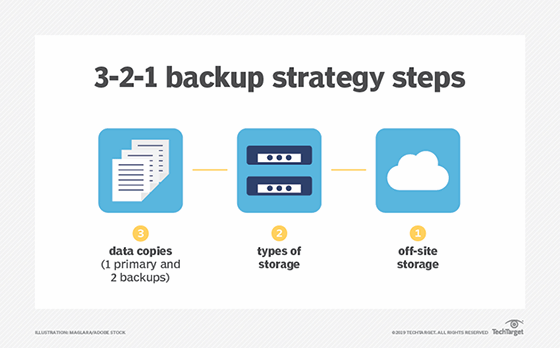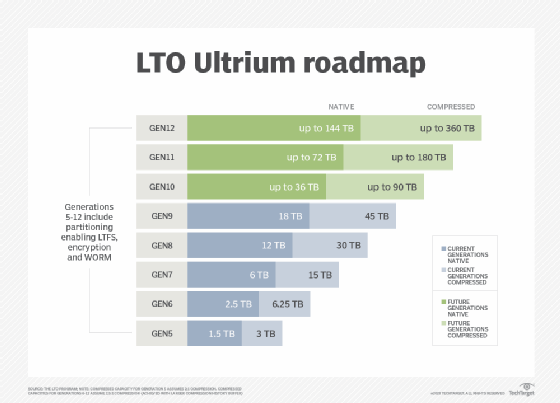
ekzman - Fotolia
How tape backup systems improve data protection
Have you analyzed your data protection lately? Tape backup could be a savior if you get hit with a ransomware attack or other malware. Learn more about five tape-related terms.
When you're creating your backup strategy, you should try "something old" and "something new."
While it's great to use newer technologies such as the cloud to protect data, tape backup systems provide a lot of benefits. For example, the ability to store a large volume in a small amount of space is important in this age of massive data growth and strict compliance regulations. In addition, having copies of your data offline is critical at a time when, unfortunately, cyberthreats are a constant presence.
Tape storage, though an old technology, is really the best form of offline backup in the event of a cyberattack that takes down a network. If you have the resources, you can kick up your data protection a notch by storing tapes off site, away from your main data center. Clearly there are quicker ways to recover data, but in the event your network or primary data center goes down, you would definitely rather have a day-old copy of your data -- that might take some time to restore -- versus nothing at all.
In this glossary, explore five key terms that provide more context and background for why tape backup systems are not just a thing of the past.
3-2-1 backup strategy. It's a tale as old as time: Three copies of your data, on at least two different media, with one copy off site. The 3-2-1 rule, though, still applies, and tape backup systems can play a big part in it.
It doesn't have to get complicated. You satisfy the rule if you're frequently backing up to disk, backing up to tape on a less frequent basis and getting those backups off site, away from your main data center. For the extra cost and logistics, 3-2-1 provides a much more comprehensive backup strategy in the face of natural disasters, cyberattacks and any other threat to your primary site.

Off-site backup. The two most common forms of off-site backup are the cloud and tape. Tape backup systems go a step further in data protection security, though, as they are also inherently offline. That's significant, given that many of today's threats come over a network. In addition, cost is a key consideration with off-site backup. With tape, you pretty much know what you're going to get in terms of the cost of storing data on a cartridge over a years-long span. Cloud backup costs can soar as the years go by and data accumulates.
Off-site backup is a good method for storing data you need to keep, but don't need to access quickly or often, such as in the case of archiving.
Ransomware recovery. In the last couple of years, ransomware attacks on cities, for example, have unfortunately become commonplace. The cost can run in the millions. In those circumstances, you don't hear enough about cities -- and other types of business -- pulling data out of tapes to get back on track. Some of these organizations surely wished they had stored at least some of their data off the network on tape backup systems. It may not be a fast recovery, but at least you can tell your staff or customers you do have their data up to a certain point.
That air gap of being disconnected from the network is critical as ransomware even has a way of getting into backups now. When you're talking about a tape stored safely away in a library, that's not going to happen.
Kilo, mega, giga, tera, peta, exa, zetta and all that. Data is increasing at such a rate we're going to hit a new quantity level: the zettabyte. That's about 1 billion TB. IDC estimates there will be dozens of zettabytes in the global datasphere within just a few years. So it's going to take a comprehensive approach to store it, because it won't all fit in the cloud or on disk. Tape will be a factor here.
The amount of data you can store on a tape cartridge continues to grow. In fact, on the LTO Ultrium roadmap, a future generation of LTO is projected to offer nearly half a petabyte of compressed capacity. Especially for types of business that create massive amounts of data -- such as healthcare, entertainment and science -- tape is a necessary play.

LTO-8. The latest generation of LTO, LTO-8, provides 30 TB compressed capacity. That's a big jump from the first version, which debuted in 2000 and offered 200 GB compressed capacity.
LTO-8 was originally supposed to be ready in 2017, but a legal battle held up production. Thankfully, according to the LTO Program, Fujifilm and Sony -- the two vendors involved in the lawsuit -- are now planning to produce LTO-8 media, with general availability expected by the end of 2019.
The time is now to get the latest version of an older technology that still benefits data protection. Tape backup systems are the way to go to make sure at least some of your data, if not most or all of it, is secure and protected from attack.







